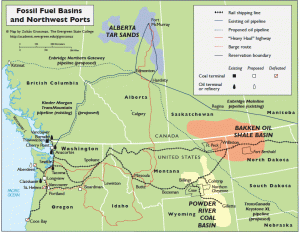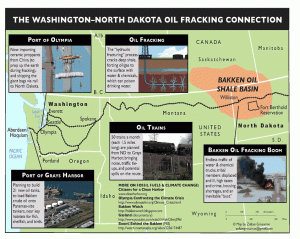Dr. Zoltán Grossman Hoquiam, April 24, 2014
My name is Zoltan Grossman; I’m a geography professor at The Evergreen State College, and co-editor of the recent book Asserting Native Resilience: Pacific Rim Indigenous Nations Face the Climate Crisis. I’ve attended numerous meetings and hearings about coal and oil trains, and I always hear the same message from the Department of Ecology about the planned increase in oil-by-rail in Washington state. There will be an increase in train shipments from the Bakken oil boom in North Dakota, it’s inevitable, it’s a done deal, so the main thing that the State can do is to beef up its oil spill response plan. I’d like to challenge this implicit assumption that permeates this process on three counts.
First, the massive increase in Bakken rail traffic is not inevitable or a done deal, but would be the result of specific decisions that have not yet been taken, such as your decision on permitting new oil terminals in Grays Harbor. Bakken crude is already coming into our state, but the massive expansion in fracking and shipping Bakken oil is reliant on new port infrastructure here in the Northwest. Build it, and they will come. Don’t build it, and they may still come, but with much lower volumes and posing much less risk. It used to be that fossil fuel companies could play a shell game and, if a community rejects trains or pipelines, they’d merely shift the burdens to another place. But with the astonishing growth of the climate justice movement around our region, Big Oil and Big Coal are hounded wherever they go: from Aberdeen to Bellingham to Coos Bay to both Vancouvers. Our climate change-conscious region has a real chance at rolling back the huge expansion of production in the three fossil fuel basins, isolated in the interior of the continent. Shipping is truly the Achilles Heel of the fossil fuel monster, and the corporations realize how vulnerable they really are.
Second, it is not the mark of a democratic society to present any decision as a done deal, without first going through a process allowing the input of the citizens. I appreciate the action of the Quinault Nation, local and state environmental groups, and the Shorelines Hearings Board that forced the Department of Ecology not merely to go back to go back and do more work, but to reverse its original flawed decision not to do an EIS and listen to the voice of the citizens. In your scoping process, we insist that you focus clearly and upfront on the specific risks that building new oil terminals would entail for Washington. Quantify how much more likely an oil explosion could happen when Bakken oil trains transit our state (there were more rail oil accidents last year than in the 27 years prior), and include the maps superimposing the Quebec blast radius on rail corridor towns. Quantify how much more likely a train spill could damage our rivers, streams, or wetlands in the corridor. Quantify how much more likely a tanker spill could happen on our coast, devastating the fishery, shellfish, and bird habitat. And when you quantify these specific increased risks, don’t just include the two or three oil terminals in Grays Harbor, but also the cumulative effects if most or all the currently planned oil terminals are built, instead of viewing them in politicized and nonecological isolation from each other.
Third, we’re tired of hearing about your enhanced oil spill response. Don’t get me wrong, I’m very glad Ecology is doing proactive and professional work on preparing for spills from oil shipments already coming through our state, and I wish only the best for your funding requests to safeguard our coast (and hopefully our inland waterways). But that’s completely different from using an improved oil spill response plan to justify or rationalize a massive increase in rail and tanker oil shipments. And these volatile Bakken trains don’t spill, they explode, as we’ve seen with the fireballs in Quebec, Alabama, and North Dakota, and the damage would be done long before your remotely stationed crews could arrive. Let me use an analogy to illustrate the absurdity of the spill response argument. A cigarette company has boxes of lighters, and wants to distribute the lighters to kids in the local grade school to promote its product. The local government acknowledges that all these lighters might increase the risk of the kids accidentally setting fires, so to offset that risk it funds a new burn unit in the local hospital. What parents would be reassured by the promised response of medical treatment, knowing that their kids would be in great danger, and the danger could be easily prevented by simply not distributing the lighters? And that’s what’s going on here: building these new oil terminals is literally playing with fire, and the role of government is to protect our kids.
On the first day of any Environmental Studies class, we talk about the Precautionary Principle, that it is more cost-effective and ethical to prevent disaster in the first place than to only plan an after-the-fact response to disaster. We insist that your EIS be firmly anchored in the sound science of the Precautionary Principle, rather than in the theoretical models of the most ideal after-the-fact spill response. Build it, and they will come, and we’re saying the simplest way to prevent the risks is: Don’t Build It. Deny the permit.
Testimony to EIS scoping hearing on Grays Harbor oil terminals
Dr. Zoltán Grossman, Centralia, April 29, 2014
My name is Zoltan Grossman, a geography professor at Evergreen. Last Thursday in Hoquiam, County Commissioner candidate Al Smith challenged Hoquiam City Administrator Brian Shay to “cease and desist” on the Grays Harbor oil terminals. I concur that this expensive EIS process could be best avoided by Hoquiam and the Port dropping all efforts to secure the three oil terminals. It must be stressful to go up against such strong public opinion in your own city, where absolutely no one testified in favor of the project last week. It must be unnerving to promote a project tied to the lucrative Bakken oil boom, only to find out too late about the multitude of safety and financial risks associated with oil-by-rail. It’s not your fault, just chalk it up to bad timing.
How were you to know when you accepted the terminal plans that three trains carrying volatile Bakken crude would explode in massive fireballs, and the NTSB would issue a warning that the oil itself may be explosive? Funny how the Port and terminal companies didn’t even know about this federal investigation when I brought it to their attention at the Ocean Shores town hall on November 14, but now the risks to the entire rail corridor have to be in the EIS.
How were you to know that public opinion would turn so strongly against fracking, which is exempt from the Safe Water Drinking Act for a good reason. Not only are the chemicals used in fracking a secret under the “Halliburton Loophole,” but now it turns out that the oil shale often contains radioactive radium more than other oil deposits, and illegal dumping of low-level radioactive waste has become a huge problem in North Dakota. The EIS should explore the radiation in the oil.
How were you to know that virtually every news story about the Bakken now highlights the social crisis brought by the massive influx of newcomers. There are extreme shortages of housing, an astronomical increase in highway accident deaths with all the water and chemical trucks on the roads. There has been a huge spike in sexual assault; women in western North Dakota don’t feel safe to go out at night even in groups. Crime has literally quadrupled, and there’s not enough jail space to fit all the new violators. So the boom has not brought paradise to North Dakota, but has brought hell. One journalist compared the Bakken “man camps” to a “commercial mining colony on Mars.” The Bakken’s unstable boom-and-bust economy should also be included in the EIS.
How were you to know that economic analysts now foresee that the Bakken boom is quickly turning into a bust. US Energy Information Agency data shows that “the Bakken’s daily decline rate from their existing oil wells has reached a staggering 63,000 barrels a day.” Production declines 44 percent in the first year of the average Bakken well. “The only way oil production is increasing in the Bakken is due to the massive number of new wells that have been added.” No wonder the Wall Street Journal reports “North Dakota Oil Boom Girds for Slowdown,” because costs for labor and scarce water have become so expensive. Hoquiam and the Port is tying the new oil terminals to a sharp but temporary oil boom, but will these 21 new tanks be left empty after the upcoming Bakken bust? Is the short-term gain worth this long-term risk? The EIS should examine impacts on the rail corridor all the way to North Dakota, rather than look at Washington state as an isolated island, which does not make any sense either economically or ecologically.
As I said last week in Hoquiam, by bringing in these risky oil terminals, you’re literally playing with fire. In DC this week, we’ve seen the huge protest of the Cowboy and Indian Alliance, traditional enemies standing together against the Keystone XL pipeline. Well here we have a Quinault alliance with commercial fishermen, which also would have been unheard of even 20 years ago. These people have already stopped a coal terminal, and they’re going to stop your oil terminals too. It takes a man to admit that his timing may have been off, to withdraw from the project with his dignity intact, and to relax a bit. Tempting, isn’t it?
DOWNLOAD MAP OF FOSSIL FUEL BASINS AND NORTHWEST PORTS

DOWNLOAD MAP OF WA-ND OIL FRACKING CONNECTIONS
